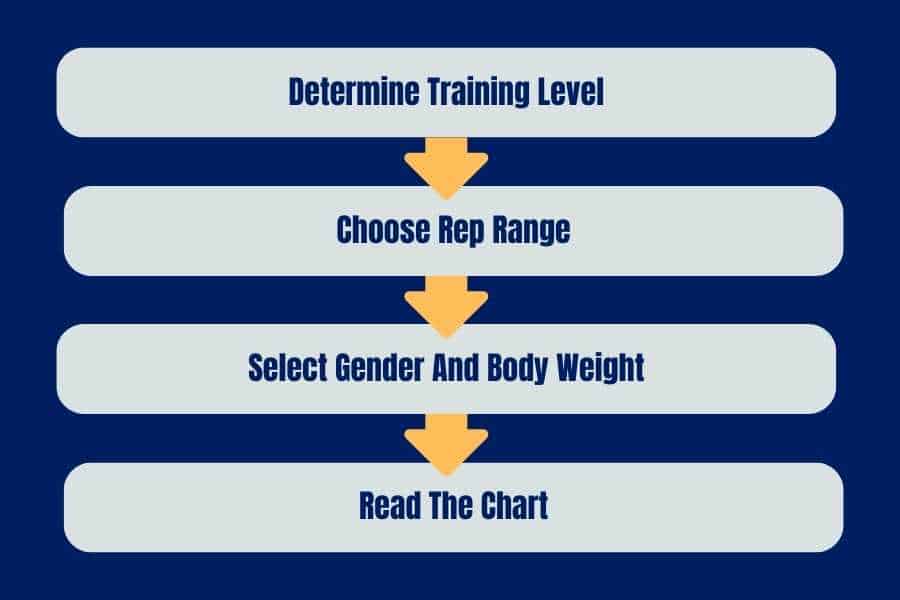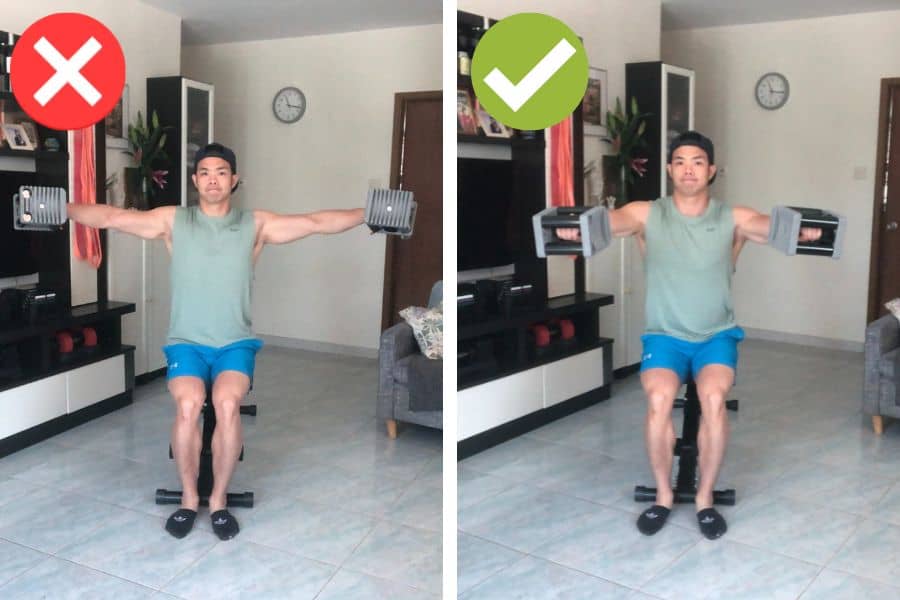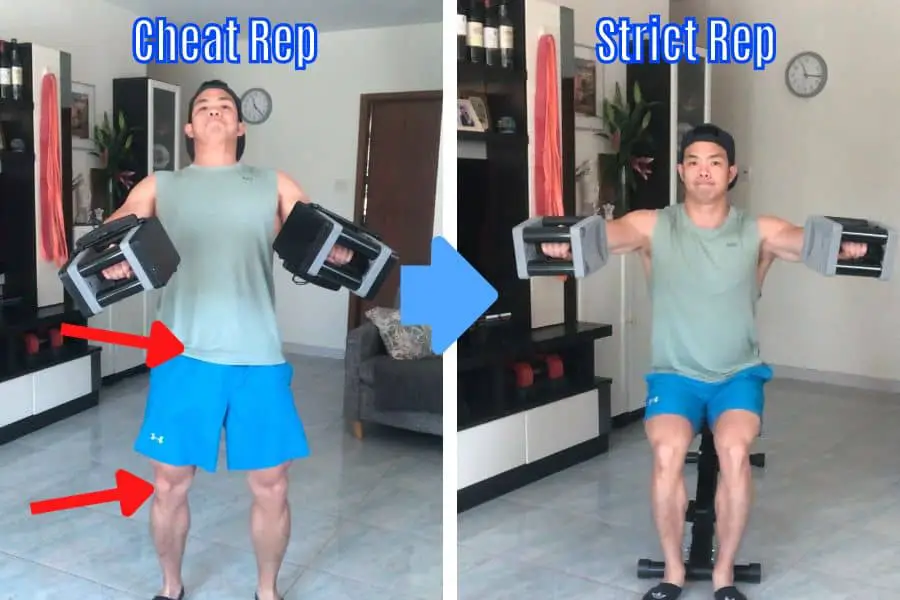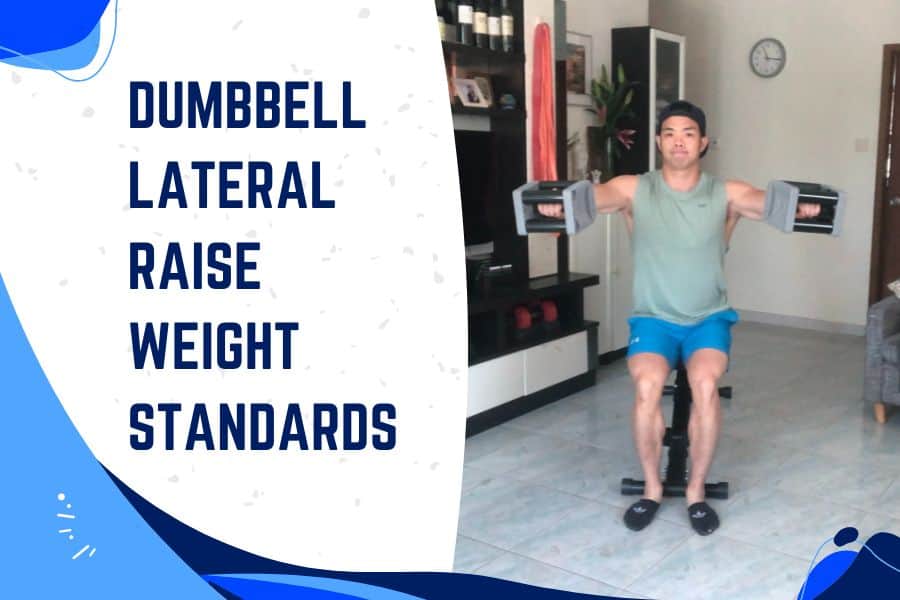Lateral raises are a great shoulder-building exercise when a suitable weight is chosen. This post reveals dumbbell lateral raise weight standards to benchmark your performance.
A respectable dumbbell lateral raise for the average male beginner is around 7% of body weight for a single repetition (both dumbbells combined). Intermediates and advanced lifters should be able to lift around 37% and 60% (respectively) for 1 rep.
The weight standards in this post will help you determine what is a respectable weight to be lifting based on your gender, body weight, and training experience.

- How To Use These Weight Standards
- Beginner Lateral Raise Weight Standards
- Intermediate Lateral Raise Weight Standards
- Advanced Lateral Raise Weight Standards
- How Good Is Your Lateral Raise Vs Others?
- 5 Reasons Why The Dumbbell Lateral Raise Is Hard
- Other Weight Standards For Lateral Raise Muscles
- Conclusion
How To Use These Weight Standards

1) Determining your training level:
- Beginners have practiced the lateral raise for 1-12 months.
- Intermediates have practiced the lateral raise for 12-36 months.
- Advanced lifters have practiced the lateral raise for 4 years or more.
2) Choosing your rep range:
The weight standards are given for:
- 1-rep max (1RM)- this is the maximum amount of weight you can lift for a single repetition. It’s often used as a strength standard.
- 6-10 working reps- this is generally considered to be the ideal rep range for building muscle.
3) Selecting your gender and body weight:
- Average lateral raise weight standards are revealed for common body weights.
- Male lateral raise standards are given.
- Females can use a 60% conversion (multiply the weight standard by 0.60).
4) Reading the charts:
- Weight standards are given as lbs on the top and kg on the bottom.
- If you’re doing the lateral raise with dumbbells at or above the weight standard for your given training level, body weight, and gender, then you are lifting a respectable amount of weight.
Beginner Lateral Raise Weight Standards
Here’s how much weight you should be lifting on the lateral raise with dumbells as a beginner:
| Bodyweight | 1-rep max | 6-rep max | 7-rep max | 8-rep max | 9-rep max | 10-rep max |
|---|---|---|---|---|---|---|
| 120lb 54kg | 8lb 4kg | 7lb 3kg | 7lb 3kg | 6lb 3kg | 6lb 3kg | 6lb 3kg |
| 150lb 68kg | 12lb 5kg | 10lb 5kg | 10lb 4kg | 10lb 4kg | 9lb 4kg | 9lb 4kg |
| 200lb 91kg | 22lb 10kg | 18lb 8kg | 18b 8kg | 18lb 8kg | 17lb 8kg | 16lb 7kg |
| 250lb 113kg | 30lb 14kg | 25lb 11kg | 25lb 11kg | 24lb 11kg | 23lb 11kg | 22lb 10kg |
| 300lb 136kg | 38lb 17kg | 32lb 14kg | 31lb 14kg | 30lb 14kg | 30lb 13kg | 28lb 13kg |
Weights are for 2 dumbbells combined.
Generally speaking, beginners should be able to lateral raise with dumbbells that weigh 5 to 10% of their body weight (both dumbbells combined) for a single repetition (1-rep max).
Intermediate Lateral Raise Weight Standards
Here’s how much weight you should be lifting on the lateral raise as an intermediate:
| Bodyweight | 1-rep max | 6-rep max | 7-rep max | 8-rep max | 9-rep max | 10-rep max |
|---|---|---|---|---|---|---|
| 120lb 54kg | 50lb 23kg | 42lb 19kg | 41lb 19kg | 40lb 18kg | 39lb 18kg | 37lb 17kg |
| 150lb 68kg | 62lb 28kg | 52lb 24kg | 51lb 23kg | 50lb 22kg | 48lb 22kg | 45lb 21kg |
| 200lb 91kg | 78lb 35kg | 66lb 30kg | 64lb 29kg | 62lb 28kg | 61lb 28kg | 57lb 26kg |
| 250lb 113kg | 94lb 43kg | 79lb 36kg | 77lb 35kg | 75lb 34kg | 73lb 33kg | 69lb 31kg |
| 300lb 136kg | 108lb 49kg | 91lb 41kg | 89lb 40kg | 86lb 39kg | 84lb 38kg | 79lb 36kg |
Weights are for 2 dumbbells combined.
Generally speaking, intermediates should be able to lateral raise with dumbbells that weigh 35 to 40% of their body weight (both dumbbells combined) for a single repetition.
Advanced Lateral Raise Weight Standards
Here’s how much weight you should be lifting on the lateral raise as an advanced lifter:
| Bodyweight | 1-rep max | 6-rep max | 7-rep max | 8-rep max | 9-rep max | 10-rep max |
|---|---|---|---|---|---|---|
| 120lb 54kg | 84lb 38kg | 71lb 32kg | 69lb 31kg | 67lb 30kg | 66lb 30kg | 61lb 28kg |
| 150lb 68kg | 100lb 45kg | 84lb 38kg | 82lb 37kg | 80lb 36kg | 78lb 35kg | 73lb 33kg |
| 200lb 91kg | 122lb 55kg | 102lb 46kg | 100lb 45kg | 98lb 44kg | 95lb 43kg | 89lb 40kg |
| 250lb 113kg | 142lb 64kg | 119lb 54kg | 116lb 53kg | 114lb 52kg | 111lb 50kg | 104lb 47kg |
| 300lb 136kg | 158lb 72kg | 133lb 60kg | 130lb 59kg | 126lb 57kg | 123lb 56kg | 115lb 52kg |
Weights are for 2 dumbbells combined.
Generally speaking, advanced lifters should be able to lateral raise with dumbbells that weigh 50 to 70% (both dumbbells combined) of their body weight for a single repetition.
How Good Is Your Lateral Raise Vs Others?
Here’s the average percentage of people who can do the dumbbell lateral raise a fraction of their own body weight:
| Lateral Raise 1RM Weight (as a fraction of body weight) | % Of People Who Can Do It |
|---|---|
| 0.10x | 96% |
| 0.20x | 84% |
| 0.30x | 67% |
| 0.40x | 49% |
| 0.50x | 33% |
| 0.60x | 21% |
| 0.70x | 13% |
| 0.80x | 7% |
| 0.90x | 4% |
| 1.00x | 2% |
Weights are for 2 dumbbells combined.
This allows you to compare your standards with others and determine how respectable your strength standards are.
To calculate your lateral raise as a fraction of your own body weight, simply divide the weight of your 1RM by your body weight.
For example: if you weigh 150lbs and your 1RM is 100lbs, then you’re lifting 0.66x your body weight (50lbs ÷ 100lbs).
The above chart indicates:
- 75% of people can lateral raise with dumbbells 0.25x their body weight for 1 rep. This represents the lower quartile of lifters and is a respectable weight for beginners to achieve.
- 50% of people can lateral raise with dumbbells 0.40x their body weight for 1 rep. This represents the median quartile of lifters and is a respectable weight for intermediates to achieve. It’s also a realistic target for beginners to aim towards with enough training.
- 25% of people can lateral raise with dumbbells 0.55x their body weight for 1 rep. This represents the upper quartile of lifters and is a respectable weight for advanced lifters. It’s also a realistic target for intermediates to aim towards with enough training.
5 Reasons Why The Dumbbell Lateral Raise Is Hard
The lateral deltoids (primary target muscles in the lateral raise) are some of the most difficult muscles to build.
Here are 5 common reasons why you may find it difficult to do the lateral raise using dumbbells, and why your strength standards are below average.
I’ve also shared solutions for each problem.
These solutions can help to improve your lateral raise.
1) Internal rotation in the shoulders

Internal shoulder rotation describes a type of movement where your shoulders round down and inwards.
For a better idea of what this looks like, you can hold your arm out towards the side (parallel to the ground) and rotate it towards the floor.
You’ll notice shoulder discomfort once a certain amount of internal rotation has occurred.
The same discomfort occurs when you do the lateral raise with your arms too far out to your side, making the exercise difficult to perform and reducing your overall strength.
Solution:
Avoid the common mistake of performing the lateral raise with the dumbbells held to your side and traveling directly outwards (like a crucifix).
Instead, the dumbbells should be held slightly to your front, with your arms slightly bent at the elbows, and travel at a slight angle from your frontal plane.
It also helps to use a lighter dumbbell to practice this form cue before progressing to heavier dumbbells.
You can check out my other post for more details on how to choose the ideal dumbbell weight for arm and shoulder exercises.
2) Training with a reduced range of motion

Range of motion (ROM) describes how far your dumbbells travel between their lowest and highest points in the exercise.
Generally speaking- reaching a full range of motion (i.e. a full rep) is better than doing a partial range of motion (i.e. a partial rep).
Partial reps have a place for training strength in specific portions of the movement.
But full reps are ideal if you are a beginner looking to build overall strength in the lateral raise and improve your weight standards.
Solution:
Perform the dumbbell lateral raise with a full ROM.
You can do this by allowing the dumbbells to touch your thighs in the lowest portion of the exercise, and bringing the dumbbells fully up in the highest portion of the exercise.
A good cue to know when to stop the upward phase of the lateral raise is when your arms reach parallel to the ground (avoid going past this point).
To do this effectively, it helps break the conventional muscle-building rule of lifting heavy for low reps, and instead reduce dumbbell weight and work in a higher rep range of 10 to 15 reps per set.
3) Cheating with body momentum

Another common form mistake made by beginners is to use body momentum to help you “swing” the dumbbells up.
This is called a cheat rep and this should be avoided.
Cheating usually happens by using leg drive and opening the hips to create an upward rocking force that helps you to lift the dumbbell.
Experienced lifters can use cheat reps to facilitate strength gains.
But when newbies do it incorrectly, it can result in severely reduced deltoid activation from the lateral raise.
Solution:
As a beginner, avoid cheat reps if your goal is to increase deltoid strength from the lateral raise.
The best way to do this is to simply perform the exercise seated on a weight bench. This prevents you from opening the hips and driving with your legs to create momentum.
All gyms have weight benches readily available. If you’re training at home, then an affordable midrange bench like this folding Flybird weight bench does the job.
Performing the lateral raise with strict form should allow you to see the first signs of strength gain within a few weeks.
4) Using too much weight

Choosing the correct dumbbell weight matters a lot in the lateral raise.
This is a small exercise targeting a very specific muscle- the lateral delts.
As such, it’s not a good idea to load too heavy in a low rep range (as is usually recommended for bigger compound lifts like the shoulder press).
Doing so may encourage cheating which will reduce deltoid activation.
But it’s not good to lift dumbbells that are too light either.
Doing so can cause you to miss out on a lot of mechanical tension. This is one of the stimuli required for muscle growth ad strength gains. Heavier weights provide greater mechanical tension.
Solution:
As a beginner, start by doing the lateral raise using a manageable dumbbell weight that challenges you for the recommended 10 to 15 reps per set.
You’ll naturally get stronger as you gain training experience.
When your current workload starts to become easy, you can apply progressive overload adding weight to your dumbbells in small increments.
Increasing weight by 1-2lb increments is sufficient to build a stronger lateral raise.
Now you can rinse, repeat, and work towards building your lateral raise to the strength standards given in this post!
5) Not performing a variety of shoulder exercises

The shoulders comprise three deltoid heads- anterior (front), lateral (middle), and posterior (rear).
The problem with only performing lateral raises is that the exercise mainly works your lateral delts.
But your anterior and posterior delts play a vital role in stabilizing the movement and allowing you to perform the lateral raise more effectively.
Thus, weakness in the anterior and posterior delts can make the lateral raise more difficult and lead to strength standards that are below average.
Solution:
Train all three delts for balanced shoulder strength development.
The lateral raise should be performed alongside other shoulder exercises as part of a balanced workout program:
| Shoulder Exercise | Deltoid Heads Worked |
|---|---|
| Shoulder press | Anterior, lateral, posterior |
| Reverse fly | Posterior |
| Front raise | Anterior |
| Incline bench press | Anterior |
| Pull-up | Posterior |
| Row | Posterior |
For more details, you can check out my home routine for skinny guys. It’s a ready-to-go 3-day workout program that builds full-body muscle, including the shoulders!
Other Weight Standards For Lateral Raise Muscles
The dumbbell lateral raise is an isolation-type movement that primarily works the lateral delts in the shoulders. But the anterior and posterior delts serve as stabilizers. Here are weight standards for other exercises that hit similar muscles:
- Shoulder press with dumbbells– vertical compound pushing exercise that works all 3 deltoid muscles.
- Reverse dumbbell fly– an isolation-type movement that focuses tension on the posterior deltoids.
- Incline dumbbell press– a compound chest movement that not only works the pecs, but also the anterior deltoids.
- Pull-ups– vertical compound pulling exercise that works all back muscles including the posterior deltoids.
- Dumbbell rows– horizontal pulling exercise that works all back muscles including the posterior deltoids.
You may also be interested in my other post on the heaviest shoulder press records.
Conclusion
These dumbbell lateral raise weight standards help you to determine whether or not you are lifting a respectable amount of weight for your capabilities.
Beginners should be able to do 1 rep using around 7% of their body weight (both dumbbells combined). Intermediates should be able to lift approximately 37% of their body weight, and advanced lifters around 60%.
If you’re lifting at or exceeding these strength standards, then you’re doing a good and respectable job.
I’ve also shared common problems and solutions to a lateral raise strength that is below average.
You may also be interested in the downloadable Kalibre Blueprint PDF which details exactly how I gained 40lbs of lean muscle (it’s 100% free!). It details the exact exercises and nutrition (with printables) I used to go from skinny to ripped!


